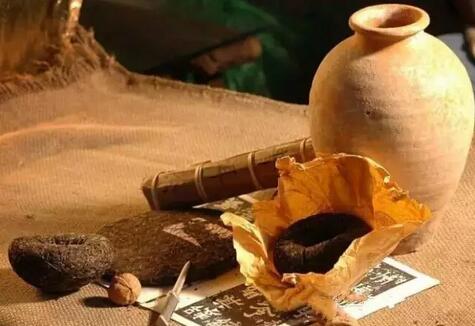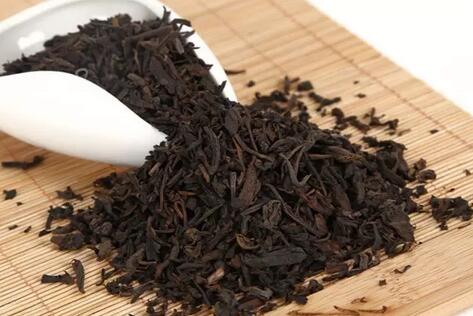According to the classification of the six major tea categories, Hunan dark tea, Yunnan Pu'er tea, and Guangxi Liubao tea all belong to dark tea. What are their differences?

In taxonomy, Pu'er belongs to the dark tea category because both types of tea are border-sale teas, and most of their products are compressed types. Moreover, both improve in taste and pharmacological effects with age, which is the basis for this classification. However, in terms of processing techniques and quality characteristics, these two types of tea have significant differences according to the classification principles of the six major tea categories.
Traditional Pu'er tea is sun-dried and called Yunnan green tea, while dark tea has a characteristic process called pile fermentation during initial processing. Pile fermentation is dominated by microbial metabolism. Although Pu'er tea also involves microbial participation during the sun-drying of raw tea, the environments (temperature and humidity conditions) are different. The former promotes the growth and reproduction of beneficial microorganisms, while the latter, after sun-drying, has a short duration and rapid water evaporation, which relatively inhibits microbial activity. Because of this, the quality characteristics of their raw teas are distinctly different. Pu'er raw tea, sun-dried raw tea, has a heavy grassy taste and a bitter and astringent soup flavor, while dark raw tea lacks the grassy taste and instead has a spicy flavor, with a mellow and less bitter taste. This is the difference between new Hunan dark tea and new raw Pu'er.
During the later storage process, although both rely on non-enzymatic oxidation and microbial action as mechanisms for quality changes, the substances formed during the raw tea processing differ in quality and quantity (due to different mechanisms), leading to different products. This is the key difference between aged Hunan dark tea and aged Yunnan raw Pu'er.

In 1973, Pu'er tea adopted post-fermentation technology, where fermentation occurs under high temperature and humidity, which is quite different from the pile fermentation process in dark tea processing. First, the reaction substrates differ. Pu'er tea's reaction substrate is based on sun-dried raw tea, while dark tea uses semi-finished products after killing green as the reaction substrate. The two cannot be confused. Second, the reaction conditions (temperature and humidity) differ, leading to natural differences in microbial populations.
According to Professor Wen Qiongying from Hunan Agricultural University, during Pu'er tea fermentation, Aspergillus niger is the dominant microorganism, while Candida is the main microorganism in Hunan dark tea. Because of these differences, the changes in the tea's own substances and metabolic products vary. Of course, if Pu'er tea undergoes post-fermentation under low temperature, low humidity, and short duration, its quality characteristics might be closer to Hunan dark tea.
Additionally, the differences in raw tea materials between Pu'er tea and Hunan dark tea are also one of the reasons for the distinct differences in tea soup concentration, color, and durability. Pu'er tea uses large-leaf varieties, which have higher polyphenol content compared to the medium and small-leaf varieties of Hunan dark tea. Therefore, Pu'er tea has stronger tea soup concentration, color, and durability.

In summary, due to differences in raw materials, processing techniques, and the resulting physicochemical change mechanisms, two types of tea with completely different quality styles are produced. Each has its own characteristics, and it is not appropriate to say which is better.
In terms of quality style: Pu'er tea has a rich and strong soup flavor, while Hunan dark tea is sweet and refreshing; Pu'er tea is durable and long-lasting, while Hunan dark tea has a lingering aged aroma (the tea soup is sweet and pure, with a prominent and lasting aged fragrance).
1. Differences in soup color: Pu'er tea soup color ranges from blue, indigo to chestnut red, deep red, and dark red, while Hunan dark tea soup color ranges from orange-yellow to orange-red.
2. Differences in taste: Pu'er tea has a strong tea flavor upon entry, while Hunan dark tea is sweet and pure. Pu'er tea is durable and long-lasting, while Hunan dark tea has a long-lasting aged charm, especially in the sweetness of the tea soup.
3. Differences in aroma: Pu'er tea aroma is quite complex, varying by region, process, storage location, and age, giving a rich and heavy overall feeling. Hunan dark tea, in comparison, is relatively simple. Generally speaking, Pu'er tea aroma is deep and heavy, while Hunan dark tea is more open and refreshing.
4. Differences in leaf base: The characteristics of the leaf base depend on the raw materials and processing techniques. Yunnan Pu'er tea is mostly made from whole buds and one bud with two or three leaves, without crushing, while Hunan dark tea requires stems and uses crushing during processing, resulting in less intact buds and leaves (high-grade dark tea has better leaf integrity).
5. Differences in function: First, in terms of tea nature, modern ripe Pu'er tea, especially aged tea, gives a warming feeling when drunk, while Hunan dark tea is cool, sweet, and thirst-quenching. Pu'er tea has unique benefits for protecting the stomach, showing no irritation and long-term drinking without harm. Hunan dark tea, especially aged dark tea, has unique therapeutic effects on stomach diseases. Both can lower blood pressure and blood lipids, shape the body, and are long-term health drinks. Additionally, Hunan dark tea has stronger effects in lowering blood sugar and treating diabetes.

Liubao tea is produced in Xunjiang, Hejiang, Guilin, Yujiang, and other areas in Guangxi. It is named after its origin in Liubao Township, Cangwu County, Wuzhou City, Guangxi.
Liubao tea has a long history of production. It was recorded in the "Wujun Lu" during the Northern and Southern Dynasties, mentioning a large-leaf tea in the south called Gualu wood, made into powdered tea, changing from bitter to mellow. By the 5th and 6th centuries, people in Guangdong and Guangxi had a common tea-drinking habit, picking fresh leaves to make compressed tea in balls, cakes, and squares. The tea produced in Guangxi is likely Liubao tea.
Liubao tea has thick and strong strips, black and oily appearance, red-yellow soup, mellow aroma, strong and refreshing taste, and yellow-brown leaf base. The finished tea has a black and glossy appearance, with golden flowers (yellow fungal spores). The soup is red and thick, with a mellow betel nut aroma, sweet and smooth taste, cool and sweet aftertaste, and red-brown leaf base. It is suitable for long-term storage and improves with age.

The processing technique of Liubao raw tea is very similar to Hunan dark tea. The processing steps of Liubao tea are: fresh leaves—killing green—initial rolling—pile fermentation—re-rolling—drying. This is consistent with the processing technique of Hunan dark raw tea. Pile fermentation and pine wood open-fire drying are also key processes in Liubao tea processing. Research shows that the pile fermentation mechanism of Liubao tea is the same as that of Hunan dark tea, so Liubao tea's quality style is similar to Hunan dark tea.
After compression, Liubao tea has higher moisture content due to lighter compression and uses natural air-drying. The tea develops fungal flowers similar to Fu tea, called "Eurotium cristatum," so Liubao tea's quality characteristics and health effects should be the same as Hunan dark tea.
Liubao tea is known for its "red, strong, aged, and mellow" qualities. It has a unique betel nut aroma and comes in brick, tuo, loose tea, and bamboo basket compressed forms. Its quality style is similar to Hunan dark tea's loose tea (Tianjian, Gongjian, Shengjian) and Fu brick tea.